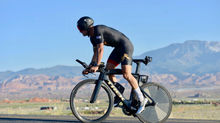The Stressors of Travel & Training
- Jason Lentzke
- Jun 3, 2023
- 3 min read

Intentionally applying physiological stressors in order to achieve optimal adaptations is necessary to improve fitness. When you become stressed in other aspects of your life, your body endures similar symptoms: your blood pressure increases, your breathing rate quickens and your adrenal glands release cortisol, a hormone that regulates the fight or flight response. Your body is essentially preparing to defend itself. Consequently, your body sees all stress through the same lens.
When you combine training stress with the added responsibilities and stressors of family, work and sleep, the juggling act gets complex. Throw travel into the mix, and it’s quite easy for your training plan to become dismantled.
Whether you’re a professional athlete or a business executive, you need to manage the physical and emotional stress episodes of travel in order to liberate your mind. Follow these tips to avoid panic, frustration and stay on track when the demands of life and travel take a toll on your training.
-Plan your travel day based on your needs as an athlete. Book a flight that allows you to get in an early morning training session. This session can be of high quality, but try to limit the intensity of any high quality running. If training before you travel is not possible, make plans to get in short "shakeout" session upon arrival. More on that later.
-Don’t arrive to your flight dehydrated and be sure to hydrate on your flight. If you have a quality session in the morning, be sure to hydrate accordingly. Bring a refillable water bottle and keep the fluids coming in. Avoid alcohol at the airport as a suppressant is going to do nothing to reduce the stress of travel.
-Don’t overeat sodium-dense airline food. Put an emphasis on hydration and if possible, bring your own nutrient dense foods. If your flight is less than 3 hours, you don’t need to eat much of anything. You don’t have to fast, but fasting probably won’t hurt you. Just don’t go overboard on the airline food and minimize the consumption of food that will make you feel terrible upon arrival.
-Get an aisle seat so you can get up once per hour to walk to the front of the plane and then to the back. You don’t need to go crazy, but try not to sit for more than 70’ at a time.
-Unplug. Take at least one hour to meditate, unplug from work or just enjoy the silence. Flying is a nice way to detach from the omnipresence of digital stimulus in our world. Bring ear plugs. Noise pollution is real! Eye covers aren’t a bad idea either.
-Dress in comfortable clothes with layers so that you can get to your optimal temperature on the flight.
-When you arrive at your final destination, head out for a 30’ jog/spin with a few 10-15 second pickups. This session should not be overly demanding. The objective of these short pickups is to engage the central nervous system and wake the muscles up. If you can’t train upon arrival due to logistics, or you trained before you left, walk to your meal, take the stairs or simply take a shower. You will feel better after you move!
-Eat a proper, nutrient dense when you land. This meal should be time-zone appropriate to help your body adapt to travel. If you need to complete that post-travel shakeout session, eat right after that. Focus on a large portion of veggies, protein, healthy fats and oils. Be sure to hydrate well as you’ve been under cabin pressure for a long time.
-Set yourself up for a successful night of sleep. Reduce screen time, cool off your room and keep the room dark to ensure a productive slumber.
In the world of an endurance athlete, traveling is simply an additional stressor. Set yourself up for success by being realistic with your training expectations and stay pragmatic. Airline travel is rarely smooth, and you can only control what you can control. Retain a big-picture lens by putting an emphasis on maintaining fitness, not building fitness. This should liberate your mind and be the blueprint of your mindset when you travel.





























Comments